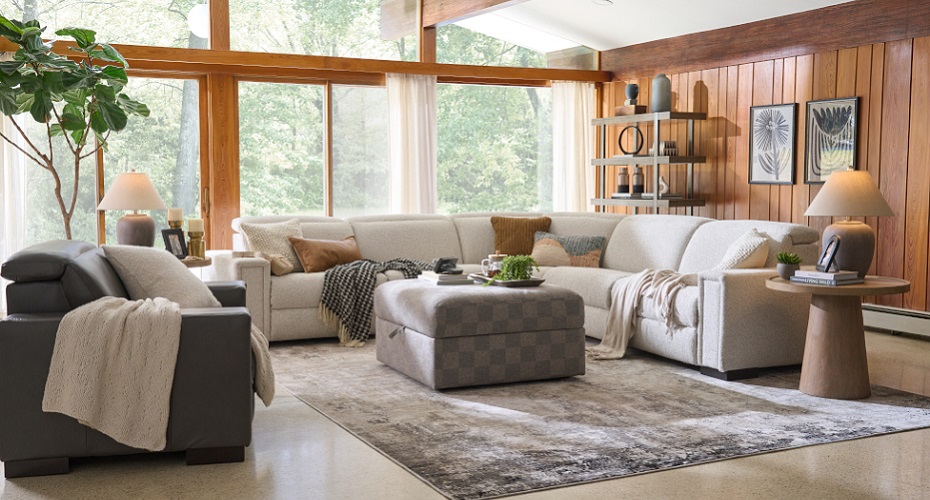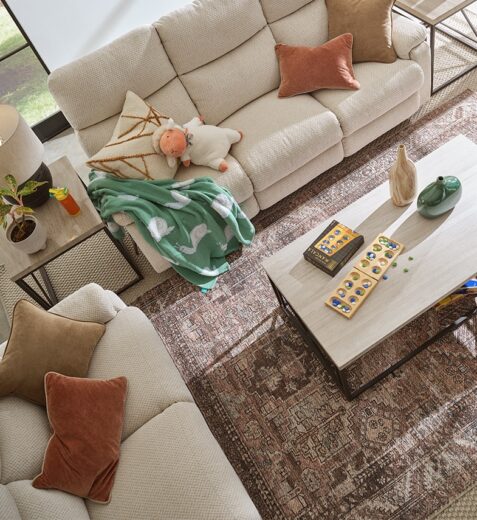Your Guide to Choosing an Area Rug for Your Home
La-Z-Boy Southeast | December 16, 2025

Choosing the right area rug doesn’t have to be complicated. This quick guide breaks down the most common rug materials—from wool and cotton to washable and synthetic options—with honest pros, cons, and pricing for each. Whether you need something durable for high-traffic areas or easy-care for homes with kids and pets, you’ll find what you need to make a confident choice. Download our guide below⬇️
Planning for Your Area Rug
Rugs add warmth, texture, and personality to a room, serving both practical and aesthetic purposes. They define spaces in open floor plans, enhance acoustics, and protect flooring.
Finding the perfect rug involves more than just picking a color or pattern. It’s a thoughtful process that considers several key factors.
Choosing the right size ensures your rug complements your furniture and the proportions of your space.
Selecting the right materials impacts not only the rug’s texture and appearance but also its durability and ease of maintenance.
Additionally, understanding the level of foot traffic your rug will experience can help determine the best construction type and material.
All of these decisions also play a major role in the final price.

Choosing the Right Rug Size
One of the first decisions to make is sizing. A rug that’s too small can make your room feel disjointed, while the right-sized rug anchors your furniture and creates visual harmony. The right rug also enhances traffic flow and helps define zones in an open floor plan.
Here are a few guidelines to help you with measuring by room:
- Living Rooms: A rug should extend under at least the front legs of your seating pieces, or be large enough to encompass the entire furniture grouping. This helps unify your space and makes the layout feel cohesive.
- Dining Rooms: Ensure the rug extends at least 24 inches beyond the edges of your table to allow chairs to slide out easily without catching on the edge of the rug.
- Bedrooms: Place rugs under the bottom two-thirds of your bed to frame the sleeping area. Alternatively, use runners on each side of the bed to add softness and comfort when stepping out.
- Foyer/Entryway: Choose a rug that fits the scale of your entry but leaves enough space around it for the door to open fully. This rug sets the tone for your home and should be both durable and welcoming.
- Kitchen: In front of sinks or high-use counters, consider a low-pile runner or small rug that adds cushion underfoot without creating a tripping hazard. Opt for easy-to-clean materials, especially in spill-prone zones.
Before selecting your rug, it’s important to know all the measurements in your space, including furniture dimensions and the distance between pieces.
At La-Z-Boy Home Furnishings & Décor, our design consultants will help sketch this out for you, ensuring you have precise measurements and a layout that works beautifully.
Whether you’re working with a compact space or an expansive open concept, we help you find the perfect fit.
Check out this video to learn more about how to place an area rug:
Types of Rug Materials
The material of your area rug plays a crucial role in how it feels underfoot, how it performs over time, and how easy it is to care for. At La-Z-Boy Home Furnishings & Décor, we educate our customers on material options to ensure their rug choice fits their lifestyle and design preferences.
Natural Fibers:
- Wool: A premium option that’s soft, durable, and naturally stain-resistant. It maintains its look for years, making it ideal for high-traffic spaces.
- Cotton: Lightweight and breathable, cotton rugs are best for casual spaces and are easy to clean.
- Jute & Sisal: Earthy, textured fibers that bring a natural feel to your space. They’re durable but may feel rough underfoot.
- Seagrass: Non-porous and moisture-resistant with a beautiful sheen. Available only in its natural color, it mellows to a warm, golden tone over time.
- Hemp: A sturdy, eco-friendly option with a rich brown hue and rustic appeal.
Synthetic Fibers:
- Polyester & Polypropylene: These fibers offer great durability and stain resistance at a lower cost. Perfect for busy households and indoor/outdoor areas.
- Viscose (Art Silk, Bamboo Silk, Banana Silk): A lustrous, silky fiber that mimics the look of luxury silk but requires more care.
For environmentally conscious buyers, plant-based fibers like jute, seagrass, and hemp are excellent choices. These materials are renewable, biodegradable, and harvested without harming the environment.
Whether you’re looking for softness in a bedroom or resilience in a hallway, a design expert can help you select the right fiber for your room’s purpose.
How Area Rugs Are Made
Not all rugs are created equal. Their construction plays a big role in both the aesthetic and practical value. Here’s a look at how they’re made from conception to completion:
1. Design & Mapping:
The process begins with design planning, sampling, and approval. Rugs are then mapped using a grid where each square represents a single knot—this meticulous planning guides the weaving process.
2. Raw Material Selection:
Wool, jute, hemp, seagrass, viscose, and more are selected and processed. Natural materials are sorted, spun, and prepared based on length, texture, and intended use.
3. Dyeing:
Materials are dyed using natural or synthetic dyes, carefully controlled to achieve consistent and lasting colors.
4. Weaving Techniques:
- Hand-Knotted: The most traditional and durable method—one knot at a time. A 9×12 rug with 100–125 knots per square inch can take over 8 months to complete.
- Hand-Tufted: Faster and more affordable, these rugs use a tufting gun to punch yarn through a backing.
- Hand-Hooked: Features looped pile; ideal for soft textures and casual designs.
- Hand-Woven & Flatweave: Low-pile rugs that are often reversible and perfect for layering.
- Power-Loomed: Machine-made rugs that provide consistent patterns and are budget-friendly.
5. Finishing Touches:
Every rug goes through up to 15 finishing steps: shaving, knot repairs, washing, stretching, carving for design clarity, and binding edges to prevent fraying. The result is a polished, high-quality product you can feel proud to bring into your home.
Area Rug Pricing
Understanding what goes into the price of a rug helps you make an informed investment. At La-Z-Boy, we explain how each factor contributes to the cost so you can find the best fit for your style and your budget.
- Materials: Natural fibers like wool and silk typically cost more than synthetic alternatives due to sourcing and longevity.
- Craftsmanship: Hand-knotted rugs are the gold standard in durability and detail, but they come with a higher price due to the labor and time involved.
- Construction Method: Machine-made and hand-tufted rugs offer great style at a more affordable price point.
- Design Complexity & Size: More intricate patterns and larger rugs naturally require more materials and labor.
- Origin: Rugs made in regions with rich weaving traditions—such as India, Iran, and Turkey—often carry a premium due to their artisanal history and authenticity.
We help you weigh these elements to find the right balance of quality, design, and value.
Durability and Maintenance
Your rug should not only look stunning but also stand the test of time. That means choosing the right material and knowing how to care for it properly.
- High-Traffic Areas: For family rooms, entryways, and hallways, we recommend rugs made from wool, nylon, or polypropylene. These materials are known for their resilience, stain resistance, and longevity.
- Low-Traffic Areas: In spaces like bedrooms or formal sitting rooms, you can indulge in more delicate materials like silk or viscose, which add a touch of luxury but require more gentle care.
- Routine Maintenance: Regular vacuuming, quick clean-ups after spills, and rotating your rug every few months help reduce uneven wear and fading. For deep-cleaning, follow the rug’s care label or consult a professional cleaning service.
- Rug Pads: Adding a rug pad underneath not only prevents slipping but also protects your floors and extends the life of your rug by reducing friction and absorbing impact.
- Rug Sprouting: A common occurrence, especially in handmade rugs, is rug sprouting. This is where small yarn fibers begin to poke above the surface due to foot traffic. It does not mean your rug is defective or unraveling. Avoid pulling on these loose fibers, which can cause further damage. Instead, simply trim them with scissors to match the height of the rest of the rug. It’s a normal part of rug aging and doesn’t impact its performance or durability.

How La-Z-Boy Can Help You Choose Your Area Rug
Choosing an area rug is one of the simplest yet most impactful ways to transform your space. At La-Z-Boy Home Furnishings & Décor, we make that process easy, educational, and enjoyable.
We proudly feature a diverse selection of rugs from trusted companies in the industry, including Oriental Weavers, Surya, Loloi, Dalyn, and more.
Our design consultants work closely with you to determine the best size, style, material, and construction for your lifestyle.
Whether you’re adding a touch of comfort to a small reading nook or anchoring a large, open-concept living area, we’d love to help you find the perfect rug to complete your home.



